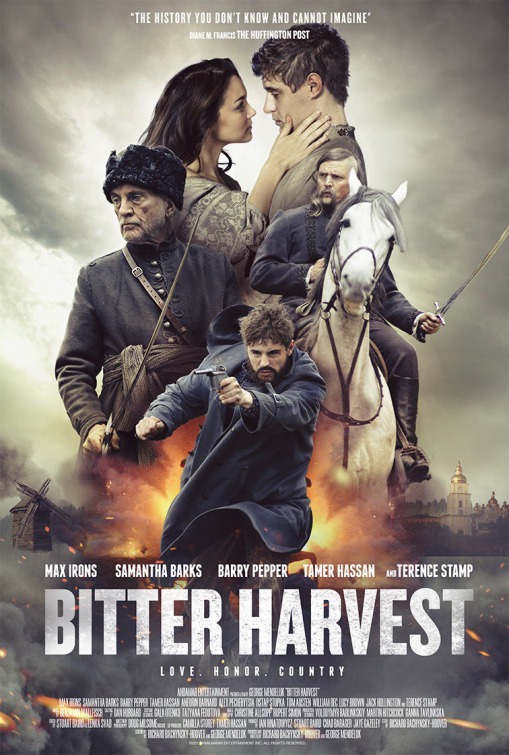I’d like to be able to praise a film about an extremely important period in world history that has not received the attention it deserves. Sad to say, George Mendeluk’s Bitter Harvest fails to tell the story of Joseph Stalin’s forced-famine in Ukraine in such a way as might have made it comparable to Steven Spielberg’s Schindler’s List (1993). Both films are about genocide and both use similar storytelling techniques: principally, the focus on one group of victims struggling to survive: in Schindler, Jewish factory workers tasked with making materiel for the Nazi war effort; in Bitter Harvest, a village of Ukrainian farmers (kulaks) fighting to retain their land, faith, and traditions against Soviet collectivization.
Mr. Spielberg (using Thomas Keneally’s award-winning novel as his source to make an even better award-winning film) told the true story of Oskar Schindler by carefully, lovingly crafting character after character and by drawing out great performances from superb actors.
Now Spielberg had a budget in the neighborhood of $40 million (that’s in 2015 dollars – perhaps the greatest bargain in Universal Pictures’ history), whereas Mr. Mendeluk was working with half that and got far, far less than half for the investment.
To be fair, the Holocaust is so clearly in the world’s collective consciousness that Spielberg’s story could be told without burdensome exposition, whereas Ukraine’s Holodomor, as it’s known (“death by starvation”), demands careful explication. And that’s not easy in a 103-minute dramatic film.
It’s not that the Holodomor is utterly unknown, but that it’s known mostly in academic histories, notably in Robert Conquest’s 1986 The Harvest of Sorrow: Soviet Collectivization and the Terror-Famine. An epigraph at the end of Bitter Harvest relates that between 7- and 10-million people died in the famine, which Joseph Stalin ordered. The actual number of deaths – mind you, in just a two-year period (1932-33) – is in dispute, but it’s no fewer than 3 million. Some estimates are as high as 12 million. Unlike the Nazis, the Russian communists weren’t meticulous accountants of their slaughter.
For me, Bitter Harvest unsuccessfully evokes Warren Beatty’s Reds (1981) by telling the story of the Holodomor against the backdrop of a love story. But the story of Yuri (Max Irons) and Natalka (Samantha Barks) has none of the allure of the true tale of Jack Reed (Beatty) and Louise Bryant (Diane Keaton), although – again – awareness of the Russian Revolution is reasonably well established.
Bitter Harvest should have been an opportunity to demolish any gauzy leftist notions about the “Soviet experiment.” Warren Beatty’s liberalism held him back from accepting the full truth about communism, yet he still crafted one of the finest portraits of disillusionment ever put on film. David Lean did the same in Dr. Zhivago (1965), as – for that matter – did Ernst Lubitsch in Ninotchka (1939). (In one of the greatest casting decisions in motion-picture history, Lubitsch got Bela Lugosi to play Commissar Razinin. What better way to incarnate Soviet evil than by hiring Dracula?)
If you watch any one of these other films, you see immediately how the medium’s visual dimension can be so powerful – can carry the viewer into a time and place with remarkable power, even adding to the narrative: pictures as words. Think of Zhivago’s amazing Varykino “ice palace” or the remarkable blizzard scenes – all of which were shot in Spain during the warmest winter in half a century!
Bitter Harvest may be the darkest film you’ll ever see, and it’s not just the somber mood, but actual darkness in most of the scenes, which are shot at night or “day-for-night” or in poorly lighted interiors. It’s hard not to conclude that something is being obscured, perhaps a lack of filmmaking technique or substandard sets . . . or substandard funding.
Mr. Mendeluk is a Canadian whose heritage is Ukrainian. Clearly, he intends to throw light on this terribly dark history. Unfortunately, Bitter Harvest is simply not going to be seen by enough people to have much impact, because it simply lacks the imaginative power necessary to create word of mouth – or to get the kind of reviews that might have helped. One likely result will be that this is the only film about the Holodomor ever produced. There’s no poison like box-office poison.
A part of the story that must have ended up on the cutting room floor is the role New York Times reporter Walter Duranty played in the tragedy. Duranty filed stories that were full of Soviet propaganda, including explicit denials of the forced famine, yet his reporting won him a Pulitzer Prize. The Internet Movie Database lists Duranty as a character in Bitter Harvest, but if there were scenes involving him I missed them. That’s too bad because his duplicity might have provided some very dramatic moments.
Stalin (Gary Oliver) appears only briefly in a couple of desultory scenes, so the viewer never really grasps the how and why of his evil plan to obliterate the Ukrainians and their Orthodox and Catholic faiths. (A subplot is the pursuit of a treasured icon, priceless to the faithful and of value to the Soviets only for the price it might bring.)
Even after De-Stalinization under Khrushchev, Soviet authorities could muster no more comment on the Holodomor than to allude to “food difficulties” during the period. Acts of the God they didn’t believe in. Russia remains in denial.
Of course, Bitter Harvest has its moments. Yuri is on a train to Kiev stopped for refueling, when a poor, scarecrow of a woman taps on the window. A conductor angrily closes the curtains.
“She’s begging for food,” Yuri says.
The conductor snarls: “There is food!”
That’s really the film’s most effective evocation of Soviet policy.
__
Bitter Harvest is rated R “for violence and disturbing images.” The cast includes Barry Pepper as Yuri’s proudly Cossack father and Terence Stamp as Yuri’s proudly Cossack grandfather.
















